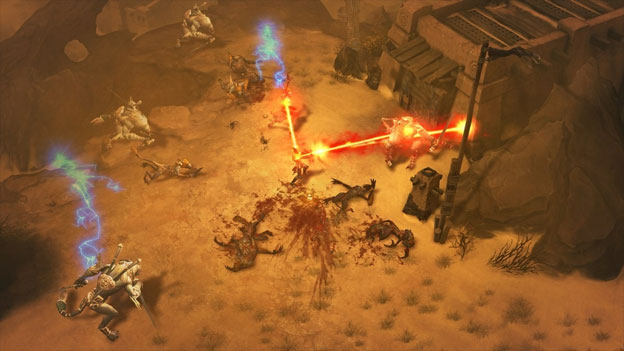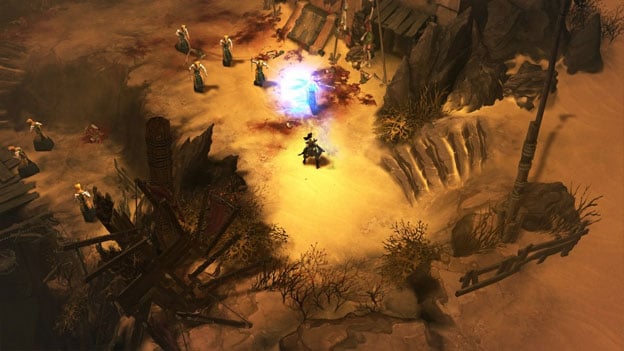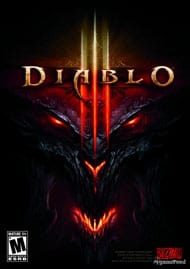One Hell Of A Good Time
There are few series capable of maintaining interest after over a decade of hiatus, with every scrap of new information poured over by a throng of gamers in anticipation of the next release. Diablo is one of those series, instilling such a compulsory need to play that one can still find gamers online, working through Diablo II for the hundredth time.
During Diablo III’s lengthy production period, we have seen would-be impersonators attempt to cash in on the loot-centric dungeon-crawler format that the second Blizzard hack and slash ushered in. Yet, even in the now-saturated genre, Diablo reinforces its position as lord of the loot. The third game is near flawless, embracing the standards of its forbearers while complementing their blueprint with every form of solo and multiplayer content we could have asked for. Most of these features are improvements, though some pose strict barriers on gameplay and technical issues unfortunately keep it off the pedestal of perfection.

Diablo II’s 2001 expansion pack, Lord of Destruction, delivered closure with the slaying of Baal, eliminating the last of the three Prime Evils of Hell. With the destruction of the corrupted Worldstone at the hands of the archangel Tyrael, the mortal realm of Sanctuary seemed destined for peace. Yet when we begin Diablo III, the venerable Deckard Cain is pouring through tomes in the ruined cathedral of Old Tristram and the prophesied End Times seem to be closer at hand than expected. A “star” shoots down from the heavens and obliterates the church, with Cain’s niece Leah witnessing the impact and apparent death of her uncle. Word of this falling “star” has spread to all corners of the world, beckoning a hero to take up arms against the demonic forces about to invade Sanctuary.
There are five different character classes equipped with various skill sets for taking out these forces. Each has its own personal back story, and each plays differently from the rest. On a basic level, the Barbarian barrels into the fray with brute strength, the Monk uses healing and precision melee attacks, the Witch Doctor inflicts curses and summons minions, the Wizard rains powerful elemental damage, and the Demon Hunter is a master at ranged attacks and subterfuge. However, these are the mere templates of each class. Not only is each character distinctive enough that you’ll be encouraged to try them all out, but each can be played in an entirely different spectrum.
For example, you could build a single-player Witch Doctor with a focus on summoning pets to pull aggro, rapid Mana generation, and life leaching skills, while at the same time playing a second Witch Doctor more suited for multiplayer, performing bolstering rituals on allies and hexes on enemies, making them easier to pick off by your team.

This, however, only becomes a luxury after gaining dozens of levels and unlocking all the skills, which until then is a frustratingly linear progression. There are both active and passive skills, which are unlocked at the appropriate levels. There is no choice in which skill you choose; it’s one specific power per level. You are only allowed to slot a certain number of skills, and the slots themselves only unlock after reaching a specific level. But once everything’s finally open and available, customizing and finding the perfect loadout requires a welcome bit of strategy and experimentation.
Active skills can also be upgraded with extra effects by attaching runes to them, allowing even more options to personalize your character. And the runes don’t just add statistical bonuses, they also affect the visuals of the powers, making for some dramatic onscreen animations.

Equipping your character will feel familiar to anyone recently coming off of Diablo II or any other grid-based inventory game, but Diablo III adds some MMO-like features to the formula. The potency of each piece is labeled with a specific color, and equipment sets can be sought after for extra bonuses when worn together. You can build your pool of money to buy new pieces in town, or even go into the persistent Auction House and purchase equipment from other players using in-game currency or real money.
The House itself is a point of contention, with a very vocal opposition, but it is completely optional and functions outside the campaign so it can be avoid altogether if you so desire. It’s well-laid-out, and finding specific items is simple, as well as keeping track of bids and sold items. The real-money auction was not live at the time of this review, so I unfortunately could not critique it.
Apart from the Auction House, you can invest gold into two artisans—the blacksmith and jeweler—learning recipes to create your own gear. Some recipes (especially recipes for rare equipment) require you to obtain plans and bring them back to the blacksmith. Also, items can be broken down into components used in the crafting process. This is a fantastic and robust feature in a loot-heavy game, making even mundane items worth picking up. The jeweler will combine lower gems into greater ones (much like the Horadric Cube did in Diablo II), as well as socket and remove them from gear. Both artisans must be leveled up with a sizable amount of gold and even some materials in or to access the higher-end recipes and gem combinations, but it makes for a worthwhile goal and a useful way to spend your ever increasing currency stockpile.
On a similar note, the Stash makes a return, where you can keep items and equipment you’d rather not sell. The chest itself has a small storage space to start, and parting with some extra gold can increase the available slots—a must-purchase, especially since your Stash is shared between all characters.
Once you’ve beefed up your character and taken on a quest or two, you can head out into the unknown, and, as expected, this comes with a lot of randomization. It’s not as static as Diablo II was, where every area outside the cities was arbitrarily generated, and some sections will remain constant no matter how many times you play through. However, random events can occur both in the overworld or the random dungeons, so every experience feels fresh.
The environments are varied and gorgeous, with a generous amount of detailing. They do seem a little faded overall, washed out from the character models. The animations are wonderful, but I can’t believe that with my graphic settings on high and the anti-aliasing checked I’m still seeing very pixelated characters. However, when playing on the standard zoomed-out isometric view instead of the overhead close-up camera (this angle seems useless except for taking action screenshots and inspecting new gear), they look decent enough. But they still don’t blend into the backdrops like I expected them to.
Engaging enemies is a simple matter of clicking on them to attack or using a hotkey. While certainly better than the left and right mouse button attacks from Diablo II, you’re still fairly limited here, with only four more hotkey slots, making six in total. After unlocking the entire skill selection, this does make for some strategic choices, but even a few more slots would have been appreciated, and the ability to have two different skill sets to swap between would have saved players a lot of time.
The music was also a little disappointing. We all know how iconic the strumming and simple synthesized tones from the first two games were, but I expected more than just a carbon copy after a decade of audio innovation. There are some nice fully orchestrated numbers, but they just don’t have that melody that will stick in your head years down the road.
The voice acting, though, is wonderfully done, and every piece of text, even the literature picked up, is verbally played back. Your character is also spared the disdain of being a mute, and each class and gender has their own well-executed vocalist.

Equally impressive are the crisp sound effects, with tons of subtle variations from upgraded skills and diverse enemies. Monsters burst with a satisfying sound, and every weapon strike feels impactful on the ears.
Diablo III is a much more engrossing experience when played with up to three other fans. Joining or creating a group is a simple process handled right in the main menu screen, and you also have the option to seamlessly open your solo game in progress to the public and watch the help pour in. You can only join up to the chapter you’ve already cleared, but since the action is addictive enough and playing different classes is worthwhile, you’ll easily fill your ten character slots for any matchup.
The combat becomes much more chaotic, but also more strategic with a group of four. The enemy count rises, as does their strength and endurance, but using thoughtful skill combinations between classes not only helps keep you alive, but looks really cool. Several of my forays into group play suffered from poor latency, causing lag and characters to pop in and out. This isn’t a tactical issue in the early going, but could prove problematic further into the game where every second counts.
The game requires a constant connection to the online servers, which makes communication with friends easier, but is a major detriment to those just looking for a solo campaign. Being disconnected or waiting for maintenance when you just want a quiet game alone is very frustrating, and the launch issues certainly haven’t helped matters.
Because of the length of production and repute of the developer, many gamers had extremely high hopes for Diablo III. These hopes might be dashed a little with server issues, visuals that aren’t as cinematic as the cutscenes, and a somewhat constrained skill system. However, Diablo III is still amazing, and after you’ve poured countless hours into numerous characters, you’ll find the purchase price fully justified. It has a great story and pertinent quests, it maintains the honor of being the best loot series ever, and it’s just simply fun to play over and over again.
Check back after the PvP release for another comprehensive look at Blizzard’s latest hack and slash. I’ll review the new multiplayer mode, explore the Hardcore and Inferno difficulties and the epic-level content, see if the Auction House has crashed, and weigh in on any new and persistent technical issues.
RATING OUT OF 5 RATING DESCRIPTION 4.4 Graphics
The backgrounds look great, as do the character models (from a distance). They just don’t look great together. 4.4 Control
The controls are simple and straightforward. Targeting enemies could have been handled better though. 4.4 Music / Sound FX / Voice Acting
I was less than impressed with the reused tunes, but blown away by the impressive vocal work. 4.8 Play Value
There’s a lot more content then people expected, and its replayability rivals just about anything else on the market. 4.5 Overall Rating – Must Buy
Not an average. See Rating legend below for a final score breakdown.
| Review Rating Legend | |||
|---|---|---|---|
| 0.1 – 1.9 = Avoid | 2.5 – 2.9 = Average | 3.5 – 3.9 = Good | 4.5 – 4.9 = Must Buy |
| 2.0 – 2.4 = Poor | 3.0 – 3.4 = Fair | 4.0 – 4.4 = Great | 5.0 = The Best |
Game Features:
